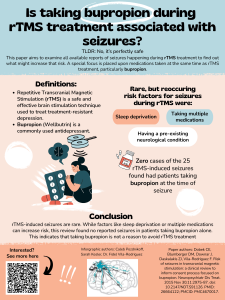Once vs. Twice: iTBS Delivers Equal Relief for Suicidal Thoughts
Paper authors: Lorina Zapf, Tyler S. Kaster, Fidel Vila-Rodriguez, Zafiris J. Daskalakis, Jonathan Downar, Daniel M. Blumberger Year of paper publication: 2025 Post authors: Caleb Pozdnikoff, Sarah Kesler, Fidel Vila-Rodriguez Check out the full research article: Zapf et al. (2025) The effect of once-daily vs. twice-daily intermittent theta burst stimulation on suicidal ideation in treatment-resistant […]
Does rTMS Improve Quality of Life in Adults?
Paper authors: Katharina Göke, Jonathan Downar, Fidel Vila-Rodriguez, Zafiris J. Daskalakis, Tarek K. Rajji, Benoit H. Mulsant, and Daniel M. Blumberger Year of paper publication: 2025 Post authors: Caleb Pozdnikoff, Lisa Ridgway, Fidel Vila-Rodriguez Download the research article: Göke et al. (2025) The effects of rTMS on self-reported quality of life in younger and older […]
Hormones and rTMS: measuring altered levels of brain activation
Researchers have previously found that sex hormones produced by the ovaries can influence how easily individual brain cells can be excited. Repetitive transcranial magnetic stimulation (rTMS) functions by exciting brain cells. Does this mean researchers need to account for fluctuating sex hormone levels when people are undergoing rTMS treatments?
This study shows that hormone changes seem to alter cortical excitability. More specifically, when estrogen levels are high, a progressive increase in brain excitability can occur. This suggests that females enrolled in repeated session rTMS treatments or research should be tested during the same phase of their menstrual cycle to ensure consistent and reliable results.
Can we shorten TMS weeks?
In the NINET Lab’s previous studies involving repetitive transcranial magnetic stimulation (rTMS) for treatment-resistant depression (TRD), the rTMS “treatment course” lasts 4-6 weeks, with one treatment each day. Could the treatment be done in fewer weeks if people got treated more than once a day?
This is the question that the current study examines. Instead of one treatment per day, this study compares the effectiveness of two treatments per day. For each treatment, researchers used a type of rTMS called intermittent theta burst stimulation (iTBS).
Does shorter rTMS work for Older Adults?
In traditional bilateral (two-sided) rTMS, it takes 47.5 minutes to do the treatment. To address long treatment times, theta burst stimulation (TBS) has been developed. TBS uses patterned bursts of stimulation that may achieve similar effects to standard rTMS in about 4 minutes. The shorter appointment time may increase the number of older adults with TRD who can access this treatment. This study was designed to assess whether this quicker bilateral TBS protocol was as effective as the standard, longer bilateral rTMS in reducing depressive symptoms in older adults with TRD.
Can rTMS treatments be shorter?
For treatment resistant-depression (TRD), there is a standard form of repetitive transcranial magnetic stimulation (rTMS) treatment. This form lasts for 37.5 minutes; a considerable amount of time for one treatment. The goal of this study was to see if the time rTMS treatments take can be reduced while remaining as effective by using a new form, called intermittent theta burst stimulation (iTBS).
Two-Sided rTMS Treatment is Better Than One-Sided for People With Treatment-Resistant Depression
Repetitive transcranial magnetic stimulation (rTMS) offers an alternative treatment for people with treatment-resistant depression. This study compared two-sided rTMS treatment to one-sided rTMS and sham (placebo) rTMS. This study also addressed limitations in other studies by using MRI to increase individualization of placing the rTMS device and extending the treatment weeks to up to six weeks.
Predicting rTMS Treatment Success for Depression Using Brain Connectivity
While repetitive transcranial magnetic stimulation (rTMS) is an effective therapy for TRD, it’s difficult to predict which patients will benefit most. To address this, finding biological markers (biomarkers) that can predict treatment response is a crucial goal for providing personalized care. This study used resting-state functional magnetic resonance imaging (fMRI) to explore brain activity patterns, aiming to discover neuroimaging biomarkers that can distinguish patients who will respond to rTMS from those who won’t.
Is taking bupropion during rTMS treatment associated with seizures?
The researchers of this paper attempted to determine if seizure risk increased when receiving rTMS and taking an antidepressant called bupropion (Wellbutrin). Researchers found that while rTMS-induced seizures are uncommon and may be linked to factors like sleep deprivation, taking multiple medications, or pre-existing neurological conditions, the review found no cases of rTMS-induced seizures in patients taking bupropion alone. This suggests that taking bupropion should not be considered a reason to avoid rTMS treatment.
rTMS & Depression: Are there other regions we should treat?
People with depression have altered activity in some parts of the brain. To treat depression, we can attempt to change this altered activity by using rTMS. However, the brain region we typically apply rTMS to only achieves remission rates of 30% to 35%. This has led researchers to explore alternative target regions that may result in a higher remission rate.









